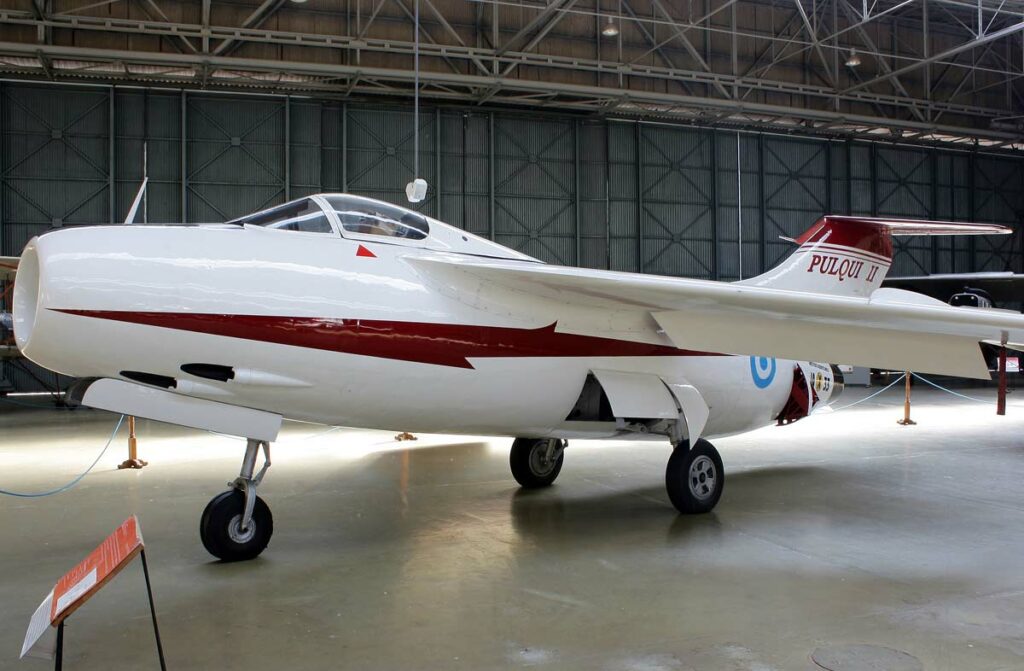The FMA IAe 33 Pulqui II is an Argentine early jet fighter, designed in the 1950s with swept wings and a Rolls-Royce engine.
In brief
The FMA IAe 33 Pulqui II, an ambitious Argentine project from the early jet era, was a significant leap in aviation for the country. Designed in the 1950s, it was one of the earliest attempts by a South American nation to develop a sophisticated jet fighter. The aircraft featured an advanced design for its time, with swept wings and a British Rolls-Royce Nene II turbojet engine. Despite its innovative aspects, the Pulqui II faced numerous challenges, including limited resources and political turmoil, which ultimately hindered its development and operational deployment. The Pulqui II remains a symbol of Argentine aerospace ambition and the complexities of aircraft development during the early Cold War era.
The FMA IAe 33 Pulqui II represents a pivotal chapter in the history of Argentine aviation, marking the country’s foray into the development of advanced jet fighters in the early Cold War period.
History of the Development of the FMA IAe 33 Pulqui II
During the mid-20th century, the emergence of jet technology revolutionized military aviation. Argentina, eager to establish itself as a regional leader in aerospace technology, embarked on an ambitious project to develop its own jet fighter. The project, known as the FMA IAe 33 Pulqui II, was initiated by the Fábrica Militar de Aviones (FMA) and led by German engineer Kurt Tank, who had previously worked on the famous Focke-Wulf FW 190.
The objective of the Pulqui II project was to create a high-performance jet fighter that could match or exceed the capabilities of contemporary designs in North America and Europe. The need for such an aircraft was driven by the desire for national prestige, self-sufficiency in defense, and the ability to keep pace with rapid advancements in military aviation technology.
The program was officially launched in the early 1950s. The Pulqui II represented a significant technological leap for Argentina, incorporating advanced features like swept wings and a pressurized cockpit, which were cutting-edge at the time.
The first flight of the Pulqui II took place on June 27, 1950. Despite not having a NATO nickname, the aircraft was closely watched by global military powers, intrigued by Argentina’s entry into the jet age.
Design of the FMA IAe 33 Pulqui II
The Pulqui II’s design was innovative and forward-thinking. It featured a 40-degree swept-wing configuration, which was crucial for achieving high speeds. The aircraft had a length of 10.6 meters (34.8 feet) and a wingspan of 10.36 meters (34 feet), embodying a compact and aerodynamic profile.
Equipped with a Rolls-Royce Nene II turbojet engine, it was capable of producing a thrust of approximately 2,200 kgf (4,850 lbf), a significant power output for the era. The choice of a British engine was due to its proven performance and reliability.
One of the design advantages was its speed and agility, but it also had drawbacks. The Pulqui II’s development faced challenges such as limited resources and technical difficulties, reflecting the complex nature of early jet fighter development. Additionally, the design’s sophistication meant that manufacturing and maintenance required advanced technical capabilities, which were challenging for Argentina at the time.

Performance of the FMA IAe 33 Pulqui II
The Pulqui II was designed to be a high-performing jet fighter. Its Rolls-Royce Nene II engine allowed a maximum speed of around 1,050 km/h (652 mph), placing it among the faster aircraft of its era. The aircraft had a service ceiling of approximately 15,000 meters (49,213 feet) and a range of about 1,300 kilometers (808 miles), making it competitive with contemporaries like the North American F-86 Sabre and the Soviet MiG-15.
In comparison to these aircraft, the Pulqui II held its own in terms of top speed and maneuverability. However, it fell short in aspects like operational range and reliability, partly due to the challenges in its development and the lack of an established aerospace industry in Argentina.
Variants of the FMA IAe 33 Pulqui II
The Pulqui II project underwent several iterations and modifications throughout its development. The most notable variants included initial prototypes with varying wing configurations and engine setups. These variants were part of the iterative process to refine the aircraft’s design and performance characteristics. However, the constant changes and lack of a clear, sustained development path led to inconsistencies and hindered the overall success of the project.
Military Use and Combat of the FMA IAe 33 Pulqui II
The Pulqui II was primarily intended for the Argentine Air Force. Its design included provisions for armaments such as cannons and hardpoints for bombs and rockets. However, the aircraft never saw combat or significant military deployment due to its protracted development and the shifting political landscape in Argentina.
The Pulqui II’s operational capabilities and potential effectiveness in combat remain largely speculative. It was not exported or used by other countries, and its development was eventually halted. The project was superseded by more advanced aircraft designs as Argentina shifted its focus to other military platforms and collaborations with established aerospace nations.
The FMA IAe 33 Pulqui II stands as a bold endeavor in the history of military aviation, symbolizing Argentina’s ambitious but ultimately unrealized aspirations in the jet age. Its development highlights the challenges faced by emerging aerospace nations in competing with established powers. The Pulqui II remains a significant, albeit footnote, in the evolution of jet fighter technology.
Back to the Fighter Jet section.